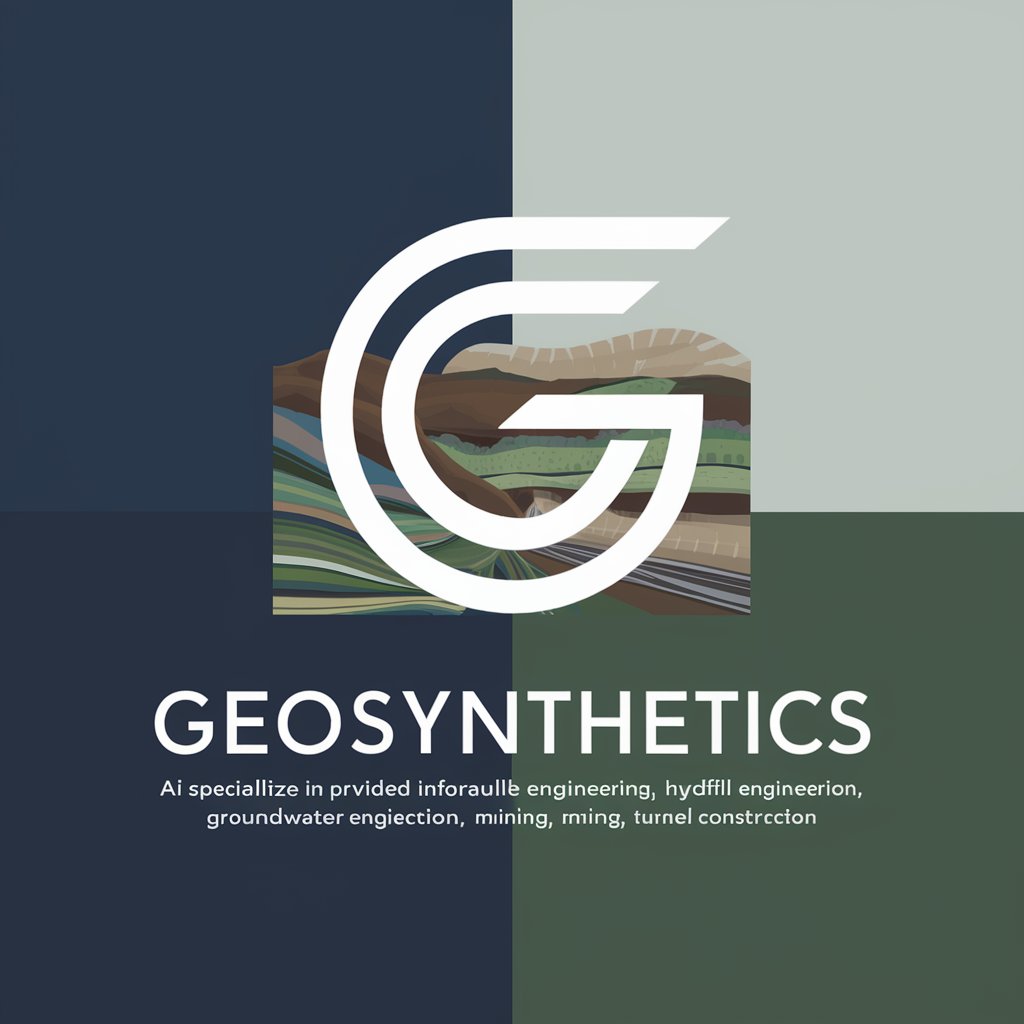Geosynthetics - tools for geosynthetics solutions.

Hello! How can I assist you with Naue geosynthetic solutions today?
Efficient geosynthetics with AI expertise.
How can Naue geosynthetics be used in hydraulic engineering projects?
What are the benefits of using Naue products for landfill construction?
Explain the applications of Naue's geosynthetic solutions in renewable energy projects.
Can you provide case studies where Naue products improved construction efficiency?
Get Embed Code
Introduction to Geosynthetics
Geosynthetics are synthetic products used in geotechnical engineering and civil construction to stabilize terrain. They are generally made from polymeric materials and serve multiple functions such as separation, filtration, reinforcement, protection, or drainage. Geosynthetics are used in a variety of applications including road construction, railway engineering, soil reinforcement, and water management. A notable example is the use of Bentofix®, a Geosynthetic Clay Liner (GCL), which is used for sealing in landfill projects, providing an essential barrier against contaminants【21†source】. Powered by ChatGPT-4o。

Main Functions of Geosynthetics
Separation
Example
Separation function prevents the mixing of distinct soil layers. For example, in road construction, geotextiles are used to maintain the integrity of the aggregate base by preventing the mixing with softer subsoil layers.
Scenario
In the construction of a roadway, a geotextile can be applied between the subgrade and the base course to keep materials separate to improve stability and load-bearing capacity.
Filtration
Example
Geosynthetics act as a filter to allow water to pass while preventing soil erosion. This is critical in protecting drainage systems from clogging with particulates.
Scenario
During the installation of drainage systems in an agricultural setting, a geotextile is used to wrap around the drainage pipes to prevent soil from filling the pipes while allowing water to flow through.
Reinforcement
Example
Used to enhance the mechanical properties of soil and other materials. Products like geogrids are used to reinforce retaining walls and slopes.
Scenario
In the reinforcement of steep slopes to prevent landslides, geogrids provide additional stability to the soil, effectively increasing the strength and safety of the embankments.
Protection
Example
Protection geosynthetics prevent the erosion of soil and damage to waterproofing layers from dynamic impacts.
Scenario
In hydraulic applications, heavy-duty geotextiles protect geomembranes from puncture while also distributing stresses from earth movements.
Drainage
Example
Geocomposites serve as channels for water flow within or adjacent to structures like roads and behind retaining walls.
Scenario
In the construction of a commercial building's foundation, geocomposites are installed to channel water away from the foundation, thus protecting the structure from water damage and hydrostatic pressure.
Ideal Users of Geosynthetics
Civil Engineers
Civil engineers utilize geosynthetics for various applications including roads, airports, and earth retaining structures, benefiting from their ability to improve durability and reduce maintenance costs.
Environmental Engineers
Environmental engineers use geosynthetics for erosion control, landfill design, and containment to ensure environmental protection and compliance with regulations.
Construction Project Managers
Project managers in construction projects employ geosynthetics to streamline installation processes and enhance the safety and longevity of the structures.
Architects and Urban Planners
Architects and urban planners integrate geosynthetics into the design of public spaces and infrastructure to achieve aesthetic and functional improvements while ensuring sustainability.

Guidelines for Using Geosynthetics
Visit yeschat.ai for a free trial without login, also no need for ChatGPT Plus.
Familiarize yourself with free resources available to guide your understanding and selection of geosynthetics.
Identify Project Requirements
Determine the project type (e.g., solar energy park, wind farm, landfill) and the specific function needed (e.g., separation, filtration, reinforcement, erosion control).
Select Suitable Geosynthetics
Choose the appropriate product(s) based on required application, environmental conditions, and engineering specifications, considering options like Bentofix®, Secumat®, or Carbofol®.
Prepare Installation Area
Clear the installation site of debris and vegetation, stabilize slopes, and ensure a solid base to optimize geosynthetic performance.
Install and Secure Geosynthetics
Follow manufacturer instructions for rolling out, overlapping, and securing geosynthetics using approved methods for consistent and durable performance.
Try other advanced and practical GPTs
Career Navigator
Craft Your Career with AI

Brand Visionary
Empowering Brand Narratives with AI

Whisky Odyssey
Unveil the Spirit of Whisky with AI

Pulumi Helper
Streamline your infrastructure with AI-driven Pulumi support.

CODE HELPER
Your AI-powered coding mentor.

Legacy GPT
Empowering efficiency with AI

Inclusivo
Empowering Inclusive Communication

Adobe Express
AI-Powered Design and Quick Actions

Blog Post / Article Image Generator + Alt Text
Visually Captivate Your Readers

Tech & Industrie Explorer
AI-Powered Insights for Tech & Industry

Apollo.io Coach
Enhance your sales with AI-powered insights.

Java & JS Full Stack Developer
Empowering development with AI-driven insights

Frequently Asked Questions on Geosynthetics
How are geosynthetics beneficial in renewable energy projects?
Geosynthetics like Secugrid® and Bentofix® provide stable foundations, erosion control, and cable protection for solar and wind energy facilities, improving longevity and efficiency.
What geosynthetic solutions are available for erosion control?
Secumat® and biodegradable coir fibre mats provide erosion control on slopes and watercourses. Secumat® is ideal for permanent installations, while coir fibre mats are biodegradable and temporary.
How does Bentofix® X work as a pond liner?
Bentofix® X forms an impermeable barrier with its polyethylene-coated layer, preventing water seepage and ensuring long-term retention for ponds and lakes.
What is the role of geosynthetics in groundwater protection?
Carbofol® geomembranes and Secudrain® drainage nets prevent hazardous materials from contaminating groundwater by providing impermeable and monitored barriers.
Why is Naue's expertise important in tunnel construction?
Naue provides specialized tunnel sealing systems with Carbofol® geomembranes, ensuring long-term protection against hydrostatic pressure, seepage, and aggressive water particles.
